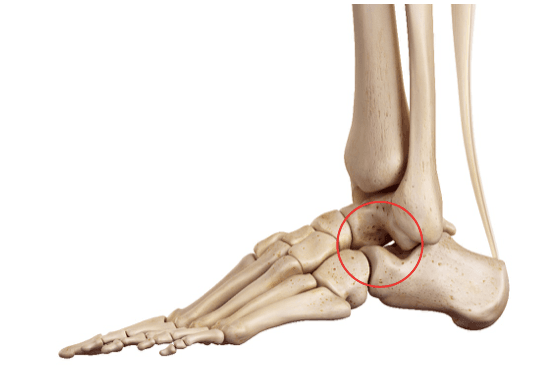Ask any group of athletes, healthcare professionals, or active individuals about foot pain, and it’s likely someone has felt a persistent, nagging ache around their lower ankle. Sinus tarsi syndrome is a source of discomfort that can frustrate not only athletes but anyone who spends significant time on their feet. Although often less discussed than common sprains or fractures, its impact on mobility, physical activity, and daily comfort is significant. Whether you’re an athlete or someone dealing with chronic foot pain, understanding sinus tarsi syndrome can help you recognize symptoms early and seek appropriate treatment. In this post, we’ll discuss the causes, symptoms, and treatment options for sinus tarsi syndrome to help you manage the condition effectively.

What Is Sinus Tarsi Syndrome?
Sinus tarsi syndrome involves pain and tenderness in a small, tunnel-like space on the outer side of the foot, just below the ankle joint. This space—called the sinus tarsi—contains important ligamentous structures, blood vessels, and nerves that help stabilize the foot and provide sensory input.
The sinus tarsi area plays a critical role in the movement of the foot, especially during activities such as walking, running, and jumping. When inflammation, injury, or repeated stress affects this area, the resulting discomfort can make simple activities surprisingly difficult. It can result in sharp or aching pain, swelling, and limited mobility. When pain arises from this region, it can disrupt daily activities, causing discomfort and difficulty walking or engaging in physical exercise.
The precise symptoms and their severity can vary from person to person, but the common thread is persistent pain deep in the foot’s lateral aspect. Understanding why this happens starts with a look at the anatomy.
Anatomy: Locating the Sinus Tarsi
Within the ankle complex, the sinus tarsi is a hollow cavity between the talus (the top bone of the foot) and calcaneus (heel bone). Several key ligaments supporting the rearfoot pass through this space, and it also houses adipose tissue and sensory nerve endings. When a person twists their foot or lands awkwardly, these delicate structures can be strained or damaged, setting the stage for chronic pain.
Here’s a simple comparison of the anatomy and function:
| Structure | Role | What Happens in Sinus Tarsi Syndrome |
|---|---|---|
| Interosseous talocalcaneal ligament | Stabilizes the rearfoot | Can become sprained or torn |
| Cervical ligament | Maintains alignment of foot bones | Prone to inflammation and injury |
| Adipose tissue | Cushions, absorbs shock | Can scar or atrophy with prolonged stress |
| Sensory nerves | Provide tactile feedback and proprioception | Transmit pain signals when irritated |
What Causes Sinus Tarsi Syndrome?
Most cases can be traced to one of two primary origins: traumatic injury or repetitive strain.
Traumatic Injury
A single injury, usually an inversion ankle sprain, is often the first step. When the foot rolls inward beyond its normal range, ligaments in the sinus tarsi area can be irritated, stretch or tear. Even after the initial pain fades, instability and chronic pain and inflammation can persist.
Chronic Ankle Instability
People who experience repeated ankle sprains or have chronic ankle instability may develop sinus tarsi syndrome. The instability in the ankle joint can cause ongoing irritation to the sinus tarsi and surrounding structures.
Repetitive Microtrauma
Others develop issues from chronic overuse. Activities that involve repetitive movements, such as running, dancing, or high-impact sports, can put excessive strain on the foot and ankle. This repetitive stress can lead to the inflammation of the sinus tarsi. High-impact activities, poor biomechanics, or improper footwear can apply unwanted stress to the structures within the sinus tarsi. Over several weeks or months, irritation builds, leading to scar tissue, swelling and pain, even in the absence of a memorable accident.
Flat Feet (Pes Planus)
Individuals with flat feet or fallen arches may be more susceptible to sinus tarsi syndrome. The abnormal alignment of the foot places additional stress on the sinus tarsi, leading to pain and inflammation.
Improper Footwear
Wearing shoes that do not provide adequate support or stability can contribute to the development of sinus tarsi syndrome. Shoes with inadequate arch support or poor cushioning can increase the risk of stress on the sinus tarsi.
Arthritis
Certain types of arthritis, such as osteoarthritis, can affect the joints in the foot and ankle, including the sinus tarsi. Inflammatory arthritis can cause swelling and discomfort in the sinus tarsi area.
Secondary Factors
While injury and overuse lead the list, certain anatomical quirks and medical conditions can amplify the problem:
- Excessive pronation or flat feet (pes planus)
- Pre-existing instability following an ankle sprain
- Localized arthritis
- Prior foot surgery
- Scar tissue from repetitive low-level trauma
Not all contributors are immediately obvious, which is why persistent lateral ankle pain deserves careful evaluation.
Recognizing the Symptoms
Sinus tarsi syndrome presents with a collection of specific signs and sensations. Some are subtle—easy to ignore at first—others prove impossible to overlook.
Identifiable Patterns
Most people with sinus tarsi syndrome describe:
- Persistent pain over the outer front (lateral) aspect of the ankle, just below the bony bump and above the heel
- Swelling, tenderness or puffiness in the area, especially after exercise or prolonged standing
- A feeling of instability or “giving way,” particularly during physical activity when turning or twisting the foot
- Due to pain and swelling, walking, running, or standing for long periods can become difficult
- Deep tenderness when gentle pressure is applied to the sinus tarsi region
- Crunchy or gritty sensations (crepitus) during ankle movement
- Some individuals experience stiffness or limited range of motion in the ankle joint
While the pain may begin as mild discomfort, it frequently escalates over time. Activities like walking on uneven ground, quick changes of direction, or prolonged periods of weight-bearing tend to spark symptoms.
Variability Based on Cause
In some, the pain feels sharp and sudden after trauma. Others develop a chronic, dull ache that waxes and wanes depending on activity level.
Nighttime discomfort is rare, as is swelling that spreads far from the immediate area. If swelling or pain becomes generalized, other causes need to be ruled out.
Differentiating Sinus Tarsi Syndrome from Other Conditions
Because the surrounding region contains multiple joints, tendons, and nerves, several other foot and ankle problems easily mimic its symptoms. Careful distinction is important.
Common conditions mistaken for sinus tarsi syndrome include:
- Ankle sprains (especially those that never fully healed)
- Lateral ligament complex injuries
- Stress fractures of the calcaneus or talus
- Peroneal tendonitis
- Subtalar joint arthritis
- Tarsal coalition (abnormal joining of bones in the hindfoot)
- Nerve entrapment syndromes
Effective diagnosis depends on blending a detailed history with a focused physical examination. Imaging studies (MRI, ultrasound, or X-rays) sometimes help identify subtle ligament injuries, scar tissue, fluid collections, or bony abnormalities. This is a very common condition in Seattle and our practice has lots of experience diagnosing and treating this condition.
Who Is Most at Risk?
A wide variety of people can be affected, but some groups are more susceptible. Among those at elevated risk:
- Athletes engaged in high-impact sports (soccer, basketball, trail running)
- Dancers, particularly those who perform repeated jumps or pivots
- People with a history of frequent or severe ankle sprains
- Individuals with mechanical foot problems (such as flat feet or high arches)
- People with connective tissue disorders or joint hypermobility
While active populations face greater odds, sedentary individuals with poor footwear or imbalanced gait are by no means immune.
Why Early Recognition Matters
Chronic inflammation in the sinus tarsi isn’t just inconvenient; it can spiral into persistent instability, altered walking patterns, and eventually degenerative joint changes. Early attention brings two key benefits:
- Increases the odds of full symptom resolution with non-operative measures
- Reduces the risk of developing long-term dysfunction or post-traumatic arthritis
This is why persistent pain around the outer ankle, particularly with a compatible history, should always be brought to Dr. Hoy’s attention.
A podiatrist typically diagnoses sinus tarsi syndrome based on your medical history, symptoms, and a physical examination of the ankle and foot. The doctor will assess the range of motion in the ankle and check for tenderness in the sinus tarsi area.
In some cases, additional diagnostic tests may be required, including:
- X-rays: These can help rule out fractures, joint damage, or other bone-related conditions.
- MRI or Ultrasound: These imaging tests may be used to visualize soft tissue damage, inflammation, or ligament injuries in the sinus tarsi area.
- Diagnostic Injections: A local anesthetic injection into the sinus tarsi can sometimes confirm the diagnosis. If the pain is relieved after the injection, it indicates that the sinus tarsi is the source of the discomfort.
Management: What Happens Next?
Treatment depends on both the severity of symptoms and underlying causes. The goal of treatment is to reduce pain, inflammation, and improve function. Common treatment options include:
1. Rest and Ice
The first line of treatment for sinus tarsi syndrome is rest and avoidance of aggravating activities. Reducing activity allows the inflamed tissues to heal. Ice therapy can help reduce swelling and alleviate pain by applying ice packs to the affected area for 15–20 minutes several times a day.
2. Anti-Inflammatory Medications
Nonsteroidal anti-inflammatory drugs (NSAIDs), such as ibuprofen or naproxen, or topical treatments, can help reduce pain and inflammation in the affected area.
3. Physical Therapy
Physical therapy can be highly effective in treating sinus tarsi syndrome. A physical therapist can use modalities such as ice, heat, or ultrasound, and teach exercises to improve strength, stability, proprioception and flexibility in the foot and ankle. This can help alleviate pressure on the sinus tarsi and prevent future injury.
4. Footwear Modifications
Use of supportive shoes, orthotic inserts, or ankle braces: Wearing proper shoes with adequate arch support and cushioning is crucial in managing sinus tarsi syndrome. Custom-made orthotic inserts may also be recommended to provide additional support and prevent further strain on the foot.
5. Corticosteroid Injections
If the pain persists despite conservative treatments, a corticosteroid injection may be recommended. This injection can help reduce inflammation and breaking the pain cycle.
6. Surgery
In severe, chronic or structurally complicated cases of sinus tarsi syndrome, surgery may be necessary. Surgical options may include:
- Sinus Tarsi Decompression: This procedure involves removing excess tissue or structures that are causing compression or irritation in the sinus tarsi area.
- Ligament Reconstruction: In cases of severe ligament damage or instability, the ligaments in the ankle may be repaired or reconstructed.
Surgery is typically considered a last resort after all conservative treatment options have been exhausted.
Adapting Daily Activities
Practical strategies often make a significant difference:
- Avoid walking barefoot on hard floors
- Choose shoes with adequate support, cushioning, and stability
- Strengthen foot and ankle muscles with targeted exercises to help prevent injury and improve stability
- Listen to pain cues and modify activity before discomfort escalates
- Take breaks during physical activity and avoid excessive strain on the foot and ankle
- If you experience an ankle sprain or injury, seek prompt medical attention and follow proper rehabilitation protocols to avoid long-term complications
Many patients notice improvement within several weeks to a few months. Patience and adherence to recommended modifications are key to optimal results.
Living with Sinus Tarsi Sensitivity
Sinus Tarsi Syndrome can be a frustrating and painful condition, but with proper treatment and care, it can be managed effectively. If you’re experiencing symptoms of sinus tarsi syndrome, it’s important to consult with a healthcare provider, such Dr. Hoy in Seattle, to determine the best course of action for your specific situation.
By addressing the condition early and following a treatment plan tailored to your needs, you can relieve pain, prevent further injury, and restore mobility to your foot and ankle.
